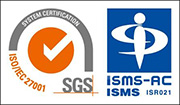サンプルスクリプト
[9-1] ドーパントの拡散解析 【Diffusion.pde】
1. 概要
この問題は、一定の不純物ソースから固体に熱的に運ばれるドーパント(半導体に添加する微量の不純物)の拡散を考慮します。
半導体拡散で典型的に使用されるパラメータを選びました。
〔 〕内は、[4. スクリプト] 項での設定値です。
表面の集中 = 1.8e20 atoms/cm^2 〔1.8e8 atom/micron^3〕拡散係数 = 3.0e-15cm^2/sec 〔1.1e-3 micron^2/hr〕
この種の問題の自然の傾向は、材料のゼロ集中と境界上の一定値で遮断することです。
これは、境界上の無限大の曲率と、拡散する粒子の無限大の移送速度を意味します。
有限要素法がステップ関数に2次方程式論を当てはめようとするので、解にオーバー・シュートも生み出します。
より良い定式化は、大きな入力流束、ドーパントが実際に境界を横切ることができる率の代表値(または、分子速度が境界上での集中不足の時間をほぼ決定します)をプログラムすることです。
ここでは、2次元パターンを生成するために、我々はマスクした不純物ソースを使います。
これは、結果が後期で解析的平面拡散結果より少し遅れる原因になります。
2. メッシュ図
{Fig.A} に解析領域の全体メッシュ図を示します。
{Fig.A} の黄色枠線部分を拡大して {Fig.B} に示します。
{Fig.A},{Fig.B} は、4項で対応するスクリプトを示します。
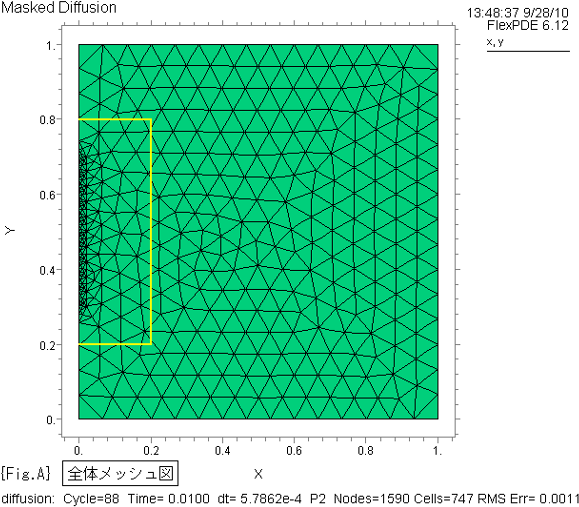
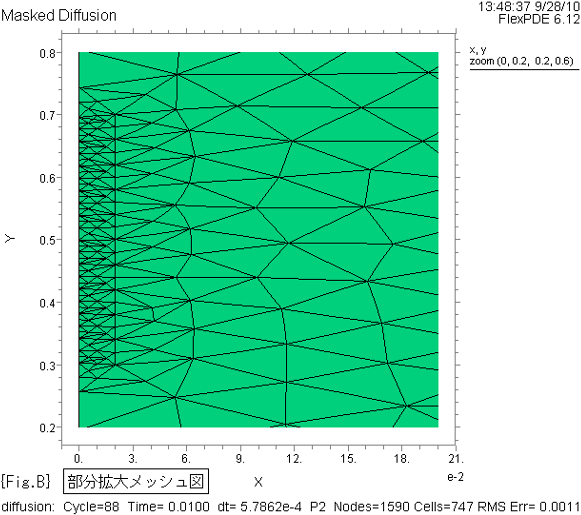
3. 解析結果
{Fig.C}~{Fig.G} は、4項で対応するスクリプトを示します。
{Fig.C},{Fig.D} に、ドーパントの拡散状況をそれぞれ2D等高線図、3D曲面図で示します。
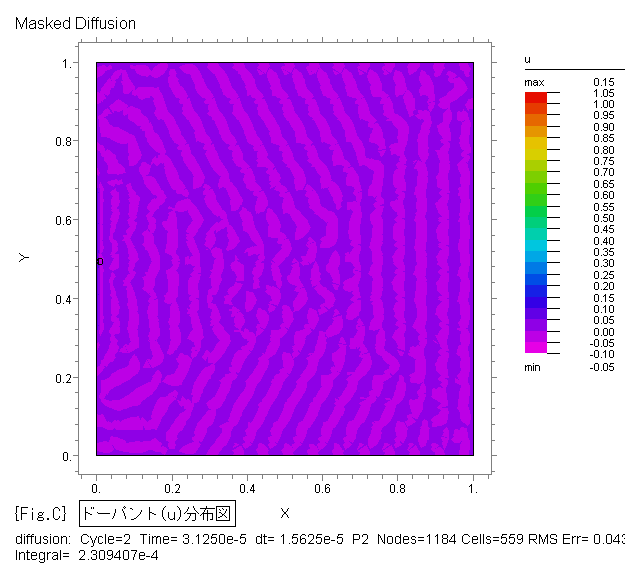
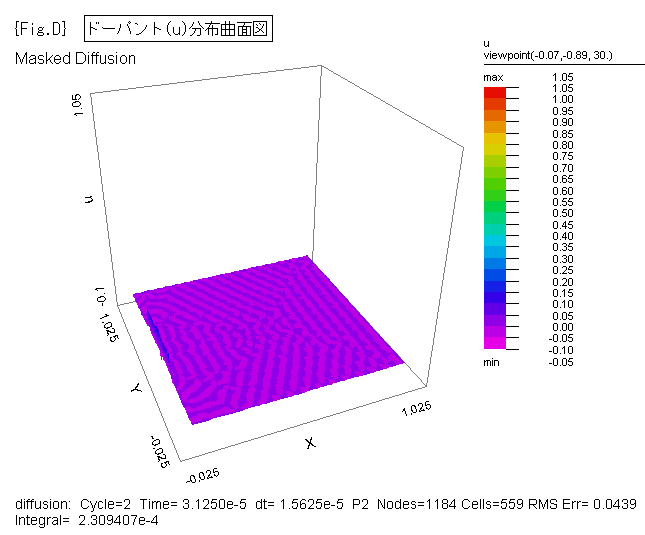
{Fig.C},{Fig.D} は、各時間(1e-5, 1e-4, 1e-3, 1e-2, 0.05, 0.1, 0.15, 0.2,
0.3, 0.4, 0.5, 0.6, 0.7, 0.8, 0.9, 1.0)ごとの状態を示す画像ファイルを FlexPDE
から出力した後、Jasc Animation Shop 等の市販ソフトでアニメ.gifファイルへ変換して作成しました。
{Fig.E} に、線分1-2上のドーパント(u)の値をグラフで示します。
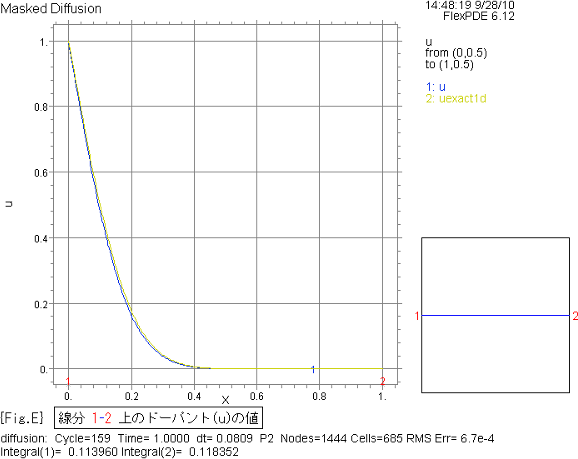
{Fig.F} に、線分1-2上のドーパント(u)の厳密解との差をグラフで示します。
Y軸の目盛は1000倍した数値です。 上方に e-3 と表記しています。
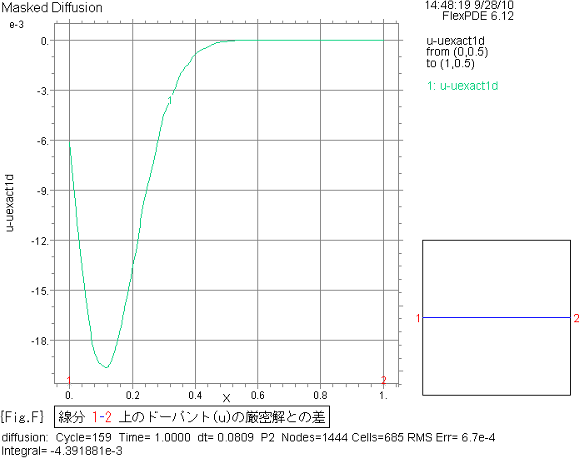
{Fig.G} に、各点におけるドーパント(u)の時間変化グラフを示します。
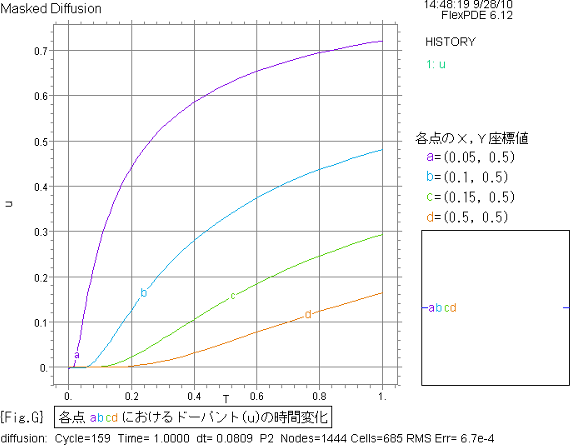
4. スクリプト
下記のスクリプトをマウスでコピーし、FlexPDE エディット・ウィンドウに貼り付けて実行する際は、日本語のコメントを除去して下さい。 そのままですと、コンパイル・エラーが発生する場合があります。
{ DIFFUSION.PDE
This problem considers the thermally driven diffusion of a dopant into
a solid from a constant source. Parameters have been chosen to be those
typically encountered in semiconductor diffusion.
surface concentration = 1.8e20 atoms/cm^2
diffusion coefficient = 3.0e-15 cm^2/sec
The natural tendency in this type of problem is to close off with zero
concentration in the material, and a fixed value on the boundary. This
implies an infinite curvature at the boundary, and an infinite transport
velocity of the diffusing particles. It also generates over-shoot
in the solution, because the Finite-Element Method tries to fit a step
function with quadratics.
A better formulation is to program a large input flux, representative of
the rate at which dopant can actually cross the boundary, (or approximately
the molecular velocity times the concentration deficiency at the boundary).
Here we use a masked source, in order to generate a 2-dimensional pattern.
This causes the result to lag a bit behind the analytical Plane-diffusion
result at late times.
}
title
'Masked Diffusion'
variables
u(threshold=0.1)
definitions
concs = 1.8e8 { surface concentration atoms/micron^3 面の集中 }
D = 1.1e-2 { diffusivity micron^2/hr 拡散係数 }
conc = concs*u
cexact1d = concs*erfc(x/(2*sqrt(D*t)))
uexact1d = erfc(x/(2*sqrt(D*t))) { u の厳密解 }
{ masked surface flux multiplier マスクした面流束の乗数 }
M = 10*upulse(y-0.3,y-0.7)
initial values
u = 0
equations
u : div(D*grad(u)) = dt(u)
boundaries
region 1
start(0,0)
natural(u) = 0 line to (1,0)
natural(u) = 0 line to (1,1)
natural(u) = 0 line to (0,1)
natural(u) = M*(1-u) line to close
feature { a "gridding feature" to help localize the activity 不純物ソース、及びメッシュ細分化の
範囲を限定します }
start (0.02,0.3) line to (0.02,0.7)
time 0 to 1 by 0.001
plots
for t=1e-5 1e-4 1e-3 1e-2 0.05 by 0.05 to 0.2 by 0.1 to endtime
{ Time=1e-5, 1e-4, 1e-3, 1e-2, 0.05, 0.1, 0.15, 0.2, 0.3, 0.4, 0.5, 0.6, 0.7, 0.8, 0.9, 1.0 について以下を
出力します }
grid(x, y) {Fig.A}
grid(x, y) zoom (0, 0.2, 0.2, 0.6) {Fig.B}
contour(u) {Fig.C}
surface(u) {Fig.D}
elevation(u,uexact1d) from (0,0.5) to (1,0.5) {Fig.E}
elevation(u-uexact1d) from (0,0.5) to (1,0.5) {Fig.F}
histories
history(u) at (0.05,0.5) (0.1,0.5) (0.15,0.5) (0.2,0.5) {Fig.G}
end

